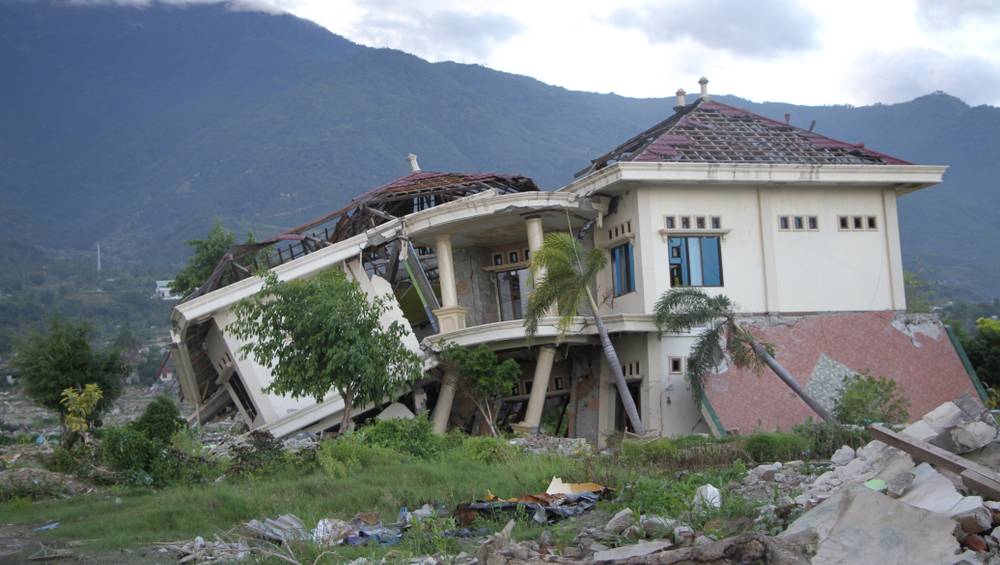news, latest-news, Dr Behzad Fatahi, rod taylor, fuzzy logic
In an earthquake, due to liquefaction, soil suddenly loses its strength and stiffness. Liquefiable soil is like porridge with heaps of lentils, fine peas or chickpeas, but with no starch to hold it together. Liquefaction happens with fast shaking in non-sticky materials such as sand or silt that is saturated. Clays and other dense soils are not prone to liquefaction because they cannot easily lose strength and stiffness during shaking. Loose soil is composed of an interconnected chain of semi-stable grains. It carries the load of structures such as buildings as well as the weight of the soil above. Below is maybe the deeper, firmer ground. When an earthquake hits, the soil grains are loosened so they slide against each other, and lose contact. The continuous chains of grains are broken. Therefore, vertical and horizontal stresses are transferred to the water, which becomes pressurised. This forms a swampy pressurised liquid with submerged soil grains inside. It flows out of the ground from low pressure points or migrates to the surrounding ground, triggering instability that can last several hours after the earthquake. Even underground pipelines may float as a result of liquefaction since the soil does not have enough strength and stiffness to hold the pipes down. Standing on loose, wet sand during a strong earthquake could be a frightening experience. The ground would be moving, and you might also see waves rippling across the surface. Then you would start sinking, and when the dust settles, depending on your weight and how deep the loose sand is, you may need an oxygen mask and diving gear to survive! That’s also what happens to structures such as buildings and roads standing on loose saturated sands. When soil loses stiffness and strength, they fail or settle enormously in a matter of seconds. On many occasions, as soon as this pressurised water gets out of the soil (so you can see a pool of water on the surface), the ground below settles and comes back to a solid state, even stronger than the pre-earthquake condition. However by that time part of structure has sunk in the mud. To prevent liquefaction below road embankments and buildings, soil can be compacted in advance or sticky and cementitious materials such as lime or Portland cement can be added to the soil. Alternatively foundations of buildings can be designed to bypass the liquefiable soil using piles and pass the structural loads from the surface to deep firm ground. The Fuzzy Logic Science Show is 11am Sundays on 2xx 98.3FM. Send your questions to [email protected] Twitter @FuzzyLogicSci Podcast FuzzyLogicOn2xx.Podbean.com
/images/transform/v1/crop/frm/Z4Q6sUEHdcmw72MBPYgZkU/031b2edd-22cf-4fad-bfa3-856659e1dacb.jpg/r0_59_1000_624_w1200_h678_fmax.jpg
Buildings located on loose saturated sand are most at risk during liquefaction. Picture: Shutterstock
In an earthquake, due to liquefaction, soil suddenly loses its strength and stiffness. Liquefiable soil is like porridge with heaps of lentils, fine peas or chickpeas, but with no starch to hold it together.
Liquefaction happens with fast shaking in non-sticky materials such as sand or silt that is saturated. Clays and other dense soils are not prone to liquefaction because they cannot easily lose strength and stiffness during shaking.
Loose soil is composed of an interconnected chain of semi-stable grains. It carries the load of structures such as buildings as well as the weight of the soil above. Below is maybe the deeper, firmer ground.
When an earthquake hits, the soil grains are loosened so they slide against each other, and lose contact. The continuous chains of grains are broken. Therefore, vertical and horizontal stresses are transferred to the water, which becomes pressurised.
This forms a swampy pressurised liquid with submerged soil grains inside. It flows out of the ground from low pressure points or migrates to the surrounding ground, triggering instability that can last several hours after the earthquake.
Even underground pipelines may float as a result of liquefaction since the soil does not have enough strength and stiffness to hold the pipes down.
Standing on loose, wet sand during a strong earthquake could be a frightening experience. The ground would be moving, and you might also see waves rippling across the surface. Then you would start sinking, and when the dust settles, depending on your weight and how deep the loose sand is, you may need an oxygen mask and diving gear to survive!
That’s also what happens to structures such as buildings and roads standing on loose saturated sands. When soil loses stiffness and strength, they fail or settle enormously in a matter of seconds.
On many occasions, as soon as this pressurised water gets out of the soil (so you can see a pool of water on the surface), the ground below settles and comes back to a solid state, even stronger than the pre-earthquake condition. However by that time part of structure has sunk in the mud. To prevent liquefaction below road embankments and buildings, soil can be compacted in advance or sticky and cementitious materials such as lime or Portland cement can be added to the soil. Alternatively foundations of buildings can be designed to bypass the liquefiable soil using piles and pass the structural loads from the surface to deep firm ground.
- Dr Behzad Fatahi is from the School of Civil and Environmental Engineering at the University of Technology, Sydney
The Fuzzy Logic Science Show is 11am Sundays on 2xx 98.3FM.
Send your questions to [email protected] Twitter @FuzzyLogicSci Podcast FuzzyLogicOn2xx.Podbean.com







